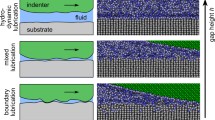Abstract
A many-body dissipative particle dynamics simulation is applied here to pave the way for investigating the behavior of mesoscale droplets after impact on horizontal solid substrates. First, hydrophobic and hydrophilic substrates are simulated through tuning the solid–liquid interfacial interaction parameters of an innovative conservative force model. The static contact angles are calculated on homogeneous and several patterned surfaces and compared with the predicted values by the Cassie’s law in order to verify the model. The results properly evaluate the amount of increase in surface superhydrophobicity as a result of surface patterning. Then drop impact phenomenon is studied by calculating the spreading factor and dimensionless height versus dimensionless time and the comparisons made between the results and the experimental values for three different static contact angles. The results show the capability of the procedure in calculating the amount of maximum spreading factor, which is a significant concept in ink-jet printing and coating process.













Similar content being viewed by others
References
Kannangara D, Zhang H, Shen W (2006) Liquid–paper interactions during liquid drop impact and recoil on paper surfaces. Colloids Surf A Physicochem Eng Asp 280:203–215
Asai A, Shioya M, Hirasawa S, Okazaki T (1993) Impact of an ink drop on paper. J Imaging Sci Technol 37:205–207
Heilmann J (2001) Measuring dynamic interactions between paper and microscale ink drops. In: Proceedings of the NIP17, international conference on digital printing technologies
Mei J, Lovell MR, Mickle MH (2005) Formulation and processing of novel conductive solution inks in continuous inkjet printing of 3-D electric circuits. IEEE Trans Electron Packag Manuf 28:265–273
Maier C, Wiesche S, Hofer EP (2000) Impact of microdrops on solid surfaces for DNA-synthesis. In: Proceedings of the 2000 international conference on modeling and simulation of microsystems
Schiaffino S, Sonin AA (1997) Molten droplet deposition and solidification at low Weber numbers. Phys Fluids 9:3172–3187
Rioboo R, Marengo M, Tropea C (2002) Time evolution of liquid drop impact onto solid, dry surfaces. Exp Fluids 33:112–124
Son Y, Kim C, Yang DH, Ahn DJ (2008) Spreading of an inkjet droplet on a solid surface with a controlled contact angle at low Weber and Reynolds numbers. Langmuir 24:2900–2907
Pagonabarraga I, Frenkel D (2001) Dissipative particle dynamics for interacting systems. J Chem Phys 115:5015–5026
Warren PB (2003) Vapor–liquid coexistence in many-body dissipative particle dynamics. Phys Rev E 68:066702
Hoogerbrugge PJ, Koelman JMVA (1992) Simulation microscopic hydrodynamics phenomena with dissipative particle dynamics. Europhys Lett 19:155–160
Merabia S, Pagonabarraga I (2006) A mesoscopic model for (de)wetting. Eur Phys J E 20:209–214
Berthier J, Silberzan P (2006) Microfluidics for biotechnology. Artech House, Boston
Cassie ABD, Baxter S (1944) Wettability of porous surfaces. Trans Faraday Soc 40:0546–0550
Kong B, Yang X (2006) Dissipative particle dynamics simulation of contact angle hysteresis on a patterned solid/air composite surface. Langmuir 22:2065–2073
Espanol P, Warren P (1995) Statistical-mechanics of dissipative particle dynamics. Europhys Lett 30:191–196
Groot RD, Warren PB (1997) Dissipative particle dynamics: bridging the gap between atomistic and mesoscopic simulation. J Chem Phys 107:4423–4435
Clark AT, Lal M, Ruddock JN, Warren PB (2000) Mesoscopic simulation of drops in gravitational and shear fields. Langmuir 16:6342–6350
Lees AW, Edwards SF (1972) The computer study of transport processes under extreme conditions. J Phys C Solid State Phys 5:1921–1929
Henrich B, Cupelli C, Moseler M, Santer M (2007) An adhesive DPD wall model for dynamic wetting. EPL 80:60004
Revenga M, Zuniga I, Espanol P, Pagonabarraga I (1998) Boundary models in DPD. Int J Mod Phys C 9:1319–1328
Karniadakis G, Beskok A, Aluru N (2005) Microflows and nanoflows. Springer, New York
Author information
Authors and Affiliations
Corresponding author
Rights and permissions
About this article
Cite this article
Ghorbani, N., Pishevar, A. A mesoscopic simulation of static and dynamic wetting using many-body dissipative particle dynamics. Comp. Part. Mech. 5, 113–123 (2018). https://doi.org/10.1007/s40571-017-0157-4
Received:
Revised:
Accepted:
Published:
Issue Date:
DOI: https://doi.org/10.1007/s40571-017-0157-4




